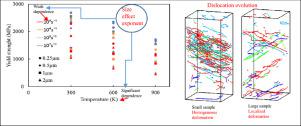当前位置:
X-MOL 学术
›
Mech. Mater.
›
论文详情
Our official English website, www.x-mol.net, welcomes your
feedback! (Note: you will need to create a separate account there.)
On The Strain Rate Sensitivity of Size-Dependent Plasticity in BCC Iron at Elevated Temperatures: Discrete Dislocation Dynamics Investigation
Mechanics of Materials ( IF 3.4 ) Pub Date : 2020-09-01 , DOI: 10.1016/j.mechmat.2020.103494 Pascale El Ters , Mutasem A. Shehadeh
Mechanics of Materials ( IF 3.4 ) Pub Date : 2020-09-01 , DOI: 10.1016/j.mechmat.2020.103494 Pascale El Ters , Mutasem A. Shehadeh

|
Abstract Multiscale discrete dislocation plasticity (MDDP) simulations are carried out to investigate the mechanical response and microstructure evolution of BCC iron micropillars under combined high temperature and strain rate deformation. The simulations are conducted at sizes ranging between 0.25 μm and 2 μm under an applied deformation rate ranging between 103s−1 and 107s−1 and subjected to different temperatures. MDDP based constitutive equation interrelating the size effect exponent to strain rate and temperature is also proposed indicating that the exponent is relatively sensitive to temperature and at a lesser degree to strain rate. Detailed investigation of the microstructure shows that self-multiplication of dislocations is responsible for the strengthening mechanism in BCC iron micropillars. At low temperatures and small sizes, screw dislocations have a weak effect on plasticity for a certain period of time but subsequently control the self-multiplication process. At larger sizes, the motion of screw dislocations is responsible for plasticity at low temperatures. Due to the large volume size, screw dislocations are entangled inside the sample leading to a self-multiplication of dislocations via cross slip and other dislocation–dislocation interactions. At higher temperatures and for all sample sizes, mixed dislocations control plasticity via the multiplication of a complex network of dislocations. MDDP generated results are in good agreement with previous experimental studies on BCC metals.
中文翻译:

高温下 BCC 铁中尺寸相关塑性的应变速率敏感性:离散位错动力学研究
摘要 通过多尺度离散位错塑性(MDDP)模拟研究了BCC铁微柱在高温应变速率变形下的力学响应和微观结构演化。在 103s-1 和 107s-1 之间的应用变形率和不同温度下,以 0.25 μm 和 2 μm 之间的尺寸进行模拟。还提出了基于 MDDP 的本构方程,将尺寸效应指数与应变率和温度相关联,表明指数对温度相对敏感,对应变率的敏感程度较低。微观结构的详细研究表明位错的自倍增是 BCC 铁微柱中强化机制的原因。在低温和小尺寸下,螺位错在一段时间内对塑性的影响很小,但随后控制了自倍增过程。在较大的尺寸下,螺旋位错的运动是造成低温塑性的原因。由于体积较大,螺旋位错缠绕在样品内部,导致位错通过交叉滑移和其他位错-位错相互作用自倍增。在更高的温度和所有样本大小下,混合位错通过复杂位错网络的乘法控制可塑性。MDDP 生成的结果与先前对 BCC 金属的实验研究非常一致。螺旋位错的运动是造成低温塑性的原因。由于体积较大,螺旋位错缠绕在样品内部,导致位错通过交叉滑移和其他位错-位错相互作用自倍增。在更高的温度和所有样本大小下,混合位错通过复杂的位错网络的倍增来控制可塑性。MDDP 生成的结果与先前对 BCC 金属的实验研究非常一致。螺旋位错的运动是造成低温塑性的原因。由于体积较大,螺旋位错缠绕在样品内部,导致位错通过交叉滑移和其他位错-位错相互作用自倍增。在更高的温度和所有样本大小下,混合位错通过复杂位错网络的乘法控制可塑性。MDDP 生成的结果与先前对 BCC 金属的实验研究非常一致。混合位错通过复杂的位错网络的倍增来控制可塑性。MDDP 生成的结果与先前对 BCC 金属的实验研究非常一致。混合位错通过复杂的位错网络的倍增来控制可塑性。MDDP 生成的结果与先前对 BCC 金属的实验研究非常一致。
更新日期:2020-09-01
中文翻译:

高温下 BCC 铁中尺寸相关塑性的应变速率敏感性:离散位错动力学研究
摘要 通过多尺度离散位错塑性(MDDP)模拟研究了BCC铁微柱在高温应变速率变形下的力学响应和微观结构演化。在 103s-1 和 107s-1 之间的应用变形率和不同温度下,以 0.25 μm 和 2 μm 之间的尺寸进行模拟。还提出了基于 MDDP 的本构方程,将尺寸效应指数与应变率和温度相关联,表明指数对温度相对敏感,对应变率的敏感程度较低。微观结构的详细研究表明位错的自倍增是 BCC 铁微柱中强化机制的原因。在低温和小尺寸下,螺位错在一段时间内对塑性的影响很小,但随后控制了自倍增过程。在较大的尺寸下,螺旋位错的运动是造成低温塑性的原因。由于体积较大,螺旋位错缠绕在样品内部,导致位错通过交叉滑移和其他位错-位错相互作用自倍增。在更高的温度和所有样本大小下,混合位错通过复杂位错网络的乘法控制可塑性。MDDP 生成的结果与先前对 BCC 金属的实验研究非常一致。螺旋位错的运动是造成低温塑性的原因。由于体积较大,螺旋位错缠绕在样品内部,导致位错通过交叉滑移和其他位错-位错相互作用自倍增。在更高的温度和所有样本大小下,混合位错通过复杂的位错网络的倍增来控制可塑性。MDDP 生成的结果与先前对 BCC 金属的实验研究非常一致。螺旋位错的运动是造成低温塑性的原因。由于体积较大,螺旋位错缠绕在样品内部,导致位错通过交叉滑移和其他位错-位错相互作用自倍增。在更高的温度和所有样本大小下,混合位错通过复杂位错网络的乘法控制可塑性。MDDP 生成的结果与先前对 BCC 金属的实验研究非常一致。混合位错通过复杂的位错网络的倍增来控制可塑性。MDDP 生成的结果与先前对 BCC 金属的实验研究非常一致。混合位错通过复杂的位错网络的倍增来控制可塑性。MDDP 生成的结果与先前对 BCC 金属的实验研究非常一致。











































 京公网安备 11010802027423号
京公网安备 11010802027423号